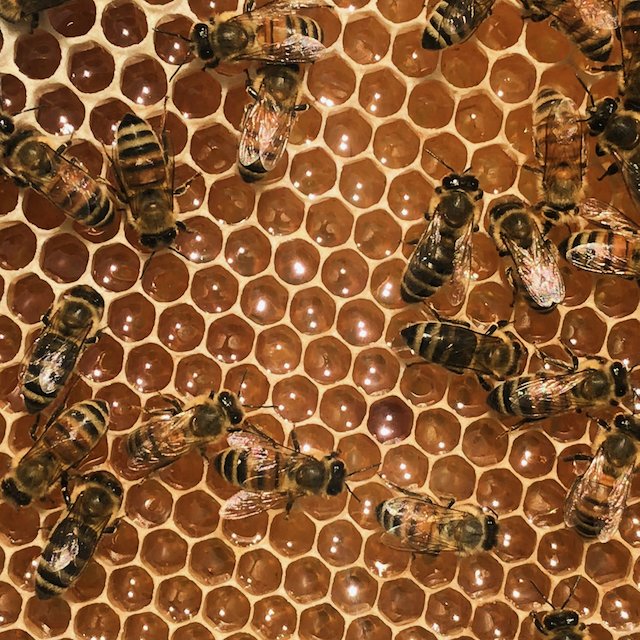
As the bees intended.
We do our best to preserve the amazing flavors and naturally occurring enzymes, vitamins, minerals, plant compounds, antioxidants, and amino acids found in real honey. The honey in our jars is as close to its natural state as possible.
Our honey is 100% pure and natural. The bees make honey from the flower nectar they gather and nothing else. We never use any kind of additives (even natural ones) or feed our bees with any sugar or syrup. Our honey isn’t heated, processed, or pasteurized, which would destroy its most important benefits.
We strain our honey several times to remove pieces of wax and debris, but it is never filtered. This means it still contains “honeybee dust,” tiny bits of pollen, which give real honey some of its awesome nutritional value. Filtration removes most or all of the pollen and usually requires heating the honey to high temperatures for easier processing.
So, why would anyone heat or filter honey? Companies that use these methods usually do so to create a consistent aesthetic for longer shelf life. Processed honey tends to be clear, golden liquid and won’t crystallize as quickly (because all of the good stuff has been filtered out and it has been pasteurized at high temps).
There’s a wealth of information out there on the benefits of real, raw honey for anyone interested in the topic. In general, we feel like it’s a good idea to get your honey from local beekeepers who can tell you all about how they care for their hives and harvest the honey. If you’d like to know more, please feel free to contact us!
Why has my honey gone through some changes…?
Real, raw honey crystallizes. This is a natural process that doesn’t change anything about the honey other than its texture. It still contains all of the natural goodness that it did in liquid form. Many people aren’t used to crystallized raw honey because the honey they bought in the past was pasteurized and ultra-filtered – which creates clear, golden liquid but eliminates many benefits of real honey.
The speed of the crystallization process and the size of the crystals can vary, depending on what kind of flower nectar the bees gathered to make that honey. Some flowers create honey that will crystallize almost overnight and make small, fine crystals. Other nectars result in honey that stays liquid longer but eventually turns into larger, gritty crystals. The temperature of the honey and water content will have an impact, as well.
Some kinds of crystals will form in layers, others will form uniformly through the jar – but none of it indicates that there’s anything wrong with the honey. It hasn’t spoiled, and it has retained all of its goodness in both flavor and nutritional benefits.
Many people enjoy crystallized honey more than its liquid form – it’s less drippy, and is easier to spread on your morning toast. However, if you prefer liquid honey, you can gently warm the jar in a pot of warm water or keep it on top of your refrigerator – the warmth will bring the honey back to its liquid state. Warming it slowly at temperatures of 95-110 degrees Fahrenheit (temps that naturally occur in a beehive during a sunny day) will preserve the best qualities of raw honey.
Crystallized vs Creamed
Creamed honey has gained popularity, and you may have seen more of these products on the shelves recently. So what exactly is creamed honey?
Despite the name, it’s not a dairy product - in fact, creamed honey is still 100% honey. “Creamed” refers to the texture, not the ingredients. The best creamed honeys are thick and smooth, spreadable and… well… creamy. Creamed honey is NOT simply another name for crystallized honey. It’s made by controlling the crystallization process so that as the liquid honey turns solid, it creates extremely fine, small, smooth crystals. This is usually done by “seeding” the fresh honey with a bit of high-quality creamed honey, keeping the batch at very specific temperatures, and stirring it at specific intervals.
Some compare creamed honey to spun, or whipped, honey - but those are often made by starting with honey that has already crystallized into larger, rougher crystals and grinding it smooth - and also incorporating a lot of air into the honey, which isn’t desirable.
As with all honeys, the end product may vary based on the type of flower nectar gathered by the bees and other factors - but in general, high-quality creamed honey is thick, ultra-smooth, and super pleasing to lick right off the spoon!
